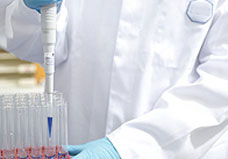| |
 |
|
|
|
|
|
|
Peyronie’s disease |
|
|
What is Peyronie’s disease?
Peyronie’s disease is characterized by a plaque, or
hard lump, that forms within the penis. The plaque, a flat plate
of scar tissue, develops on the top or bottom side of the penis
inside a thick membrane called the tunica albuginea, which
envelopes the erectile tissues. The plaque begins as a localized
inflammation and develops into a hardened scar. This plaque has no
relationship to the plaque that can develop in arteries.
Cases of Peyronie’s disease range from mild to severe. Symptoms
may develop slowly or appear overnight. In severe cases, the
hardened plaque reduces flexibility, causing pain and forcing the
penis to bend or arc during erection. In many cases, the pain
decreases over time, but the bend in the penis may remain a
problem, making sexual intercourse difficult. The sexual problems
that result can disrupt a couple’s physical and emotional
relationship and can lower a man’s self-esteem. In a small
percentage of men with the milder form of the disease,
inflammation may resolve without causing significant pain or
permanent bending.
The plaque itself is benign, or noncancerous. It is not a tumor.
Peyronie’s disease is not contagious and is not known to be caused
by any transmittable disease.
How
does Peyronie’s disease develop?
Many researchers believe the plaque of Peyronie’s disease develops
following trauma, such as hitting or bending, that causes
localized bleeding inside the penis. Two chambers known as the
corpora cavernosa run the length of the penis. A connecting
tissue, called a septum, runs between the two chambers and
attaches at the top and bottom of the tunica albuginea.
If the penis is bumped or bent, an area where the septum attaches
to the tunica albuginea may stretch beyond a limit, injuring the
tunica albuginea and rupturing small blood vessels. As a result of
aging, diminished elasticity near the point of attachment of the
septum might increase the chances of injury. In addition, the
septum can also be damaged and form tough, fibrous tissue, called
fibrosis.
The tunica albuginea has many layers, and little blood flows
through those layers. Therefore, the inflammation can be trapped
between the layers for many months. During that time, the
inflammatory cells may release substances that cause excessive
fibrosis and reduce elasticity. This chronic process eventually
forms a plaque with excessive amounts of scar tissue and causes
calcification, loss of elasticity in spots, and penile deformity.
While trauma might explain some cases of Peyronie’s disease, it
does not explain why most cases develop slowly and with no
apparent traumatic event. It also does not explain why some cases
resolve or why similar conditions such as Dupuytren’s contracture
do not seem to result from severe trauma.
How is
Peyronie’s disease treated?
Men with Peyronie’s disease usually seek medical attention because
of painful erections, penile deformity, or difficulty with
intercourse. Because the cause of Peyronie’s disease and its
development are not well understood, doctors treat the disease
empirically; that is, they prescribe and continue methods that
seem to help. The goal of therapy is to restore and maintain the
ability to have intercourse. Providing education about the disease
and its course often is all that is required. No strong evidence
shows that any treatment other than surgery is universally
effective. Experts usually recommend surgery only in long-term
cases in which the disease is stabilized and the deformity
prevents intercourse.
Because the course of Peyronie’s disease is different in each
patient and because some patients experience improvement without
treatment, medical experts suggest waiting 1 year or longer before
having surgery. During that wait, patients often are willing to
undergo treatments whose effectiveness has not been proven.
|
|
|
|
Peyronie’s disease - treatment of Peyronie’s
disease, Peyronie’s disease types, Disease medicines, Peyronie’s disease
symptoms, Peyronie’s disease and Disease symptoms, Peyronie’s disease
symptoms Disease and diagnosis, Symptoms and Solutions, Signs and Symptoms,
type of Peyronie’s disease, cause common, common Peyronie’s disease,
Peyronie’s disease List, causes list, Infectious Peyronie’s disease, Causes,
Diseases , Types, Prevention, Treatment and Facts, Peyronie’s disease
information, Peyronie’s disease: Definition, Peyronie’s disease names,
medical Peyronie’s disease, medical Peyronie’s disease and disorders, cell
Peyronie’s disease, Peyronie’s disease Worldwide, Peyronie’s disease
Research, Peyronie’s disease Control, Peyronie’s disease Center, Digestive
Peyronie’s disease Week, Information about Peyronie’s disease, causes of
different Peyronie’s disease, Peyronie’s disease Articles, Peyronie’s
disease and conditions, Health and Peyronie’s disease, Peyronie’s disease
Patients, Peyronie’s disease and Sciences, causes of alzheimer's Peyronie’s
disease, Peyronie’s disease causes, alternative medicine heart Peyronie’s
disease, body ailments, Peyronie’s disease medicines, medical antiques, type
of blood Peyronie’s disease |
|
|





